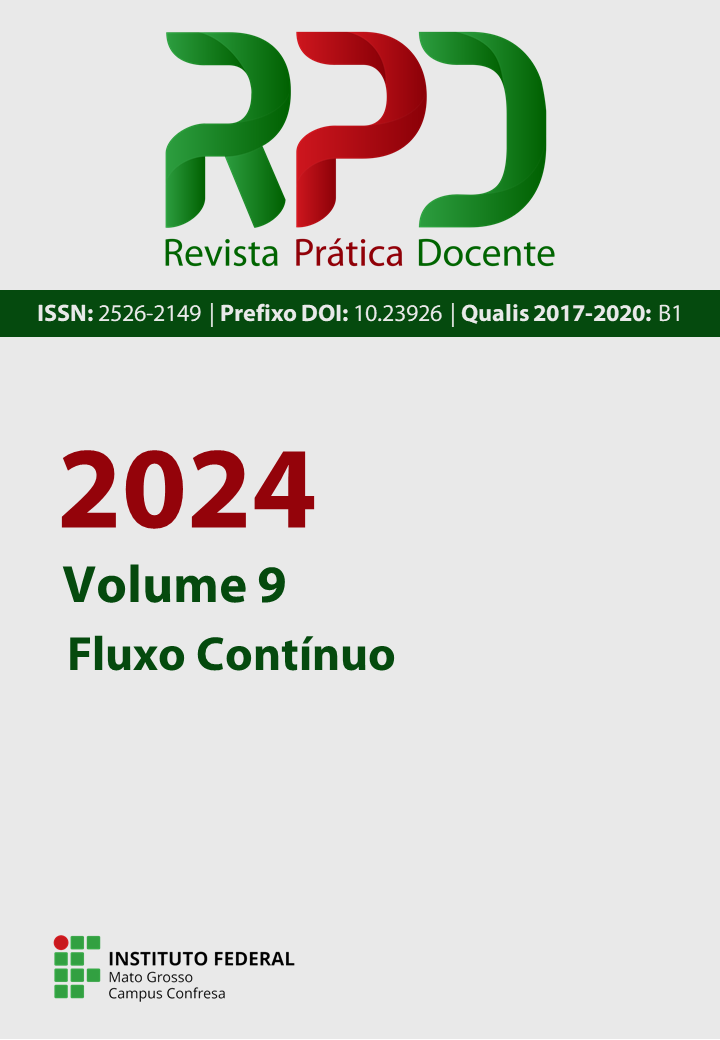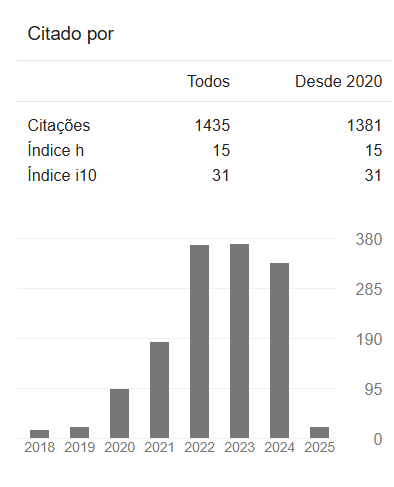Teaching Geography to Blind People: The Journey of Developing and Evaluating a Tactile Cartography Material with Natural and Recyclable Elements
DOI:
10.23926/RPD.2024.v9.e24002.id730Keywords:
Visual Impairment, Inclusion, Sustainability., Handcrafted ManufacturingAbstract
This study is an applied, qualitative, and exploratory pedagogical investigation. The target audience comprises blind individuals residing in the state of Mato Grosso, who have been or are currently educated in this region. Data collection employed scripts, questionnaires, note-taking, and audio recording, analyzed in light of the characteristics advocated by authors in the field. The aim was to develop a set of accessible and sustainable educational resources for teaching Geography to blind individuals using biodegradable elements. According to the findings, although functional, with a variety of textures and innovative, the resources may have limited durability and quality when frequently manipulated, and so far, no means have been identified to maintain resilience over extended periods. Additionally, the complexity of collection, treatment, and construction processes may hinder material reproduction. It is concluded that further investigations and in-depth studies are necessary regarding the utilization and conservation of these elements for educational purposes.
Downloads
Metrics
References
BRASIL. [Lei n. 13.146, de 6 de julho de 2015 (2015)]. Lei Brasileira de Inclusão da Pessoa com Deficiência. Brasília, DF. Disponível em: http://www.planalto.gov.br/ccivil_03/_ato2015-2018/2015/lei/l13146.htm. Acesso em: Setembro de 2022.
BRASIL. [Decreto nº 6.949 de 25 de agosto de 2009(2008)]. Política Nacional de Educação Especial na Perspectiva da Educação Inclusiva. Brasília, DF. Disponível em: https://legis.senado.leg.br/norma/579385/publicacao/15748546. Acesso em: set. de 2022.
BOGDAN, Roberto et al. Investigação Qualitativa em Educação: uma introdução à teoria e aos métodos. Porto: Porto, 1994. 333 p.
CERQUEIRA, Jonir; FERREIRA, Elise. Recursos didáticos na educação especial. Benjamin Constant, n. 15, 2000. Disponível em: http://revista.ibc.gov.br/index.php/BC/article/view/602. Acesso em: nov. de 2021.
COBO, Ana; RODRÍGUEZ, Manuel; BUENO, Salvador. Personalidade e auto-imagem do cego. In: MARTÍN, Manuel; BUENO, Salvador (Org.). Deficiência visual: aspectos psicoevolutivos e educativos. Santos, 2003. p. 97-113.
COUTO JUNIOR, Abelardo; OLIVEIRA, Lucas. The main causes of blindness and low vision in school for blind. Revista Brasileira de Oftalmologia, [S.L.], v. 75, n. 1, p. 26-29, 2016. Disponível em: http://dx.doi.org/10.5935/0034-7280.20160006. Acesso em: out. 2021.
FERREIRA, Gracialda. Diretrizes para coleta, herborização e identificação de material botânico nas Parcelas Permanentes em florestas naturais da Amazônia brasileira. 1. ed. Manaus: [s. n.], 2008. 44 p. v. 1. Disponível em: https://files.cercomp.ufg.br/weby/up/417/o/manual_diretrizes_coletas_botanicas.pdf?1494003886. Acesso em: nov. 2021
FREITAS JUNIOR, Robson Lopes. Revisão teórico-metodológica. In: FREITAS JUNIOR, Robson Lopes. Práticas de ensino fundamental em Geografia, através de Geotecnologias, no âmbito da educação especial para alunos de baixa visão do Instituto Benjamin Constant (IBC) – município do Rio de Janeiro. 2018. Tese (Doutorado em Geografia), Rio de Janeiro, 2018. p. 171. Disponível em: https://www.bdtd.uerj.br:8443/handle/1/13216. Acesso em: out. 2021.
GARCIA, Rosalba; KUHNEN, Roseli. POLÍTICAS PÚBLICAS EM EDUCAÇÃO ESPECIAL EM TEMPOS DE DITADURA: uma análise sobre a concepção de deficiência no brasil no período 1973- 1985. Revista Educação, Pesquisa e Inclusão, [S.L.], v. 1, n. 1, p. 69, 15 maio de 2020. Universidade Federal de Roraima. http://dx.doi.org/10.18227/2675-3294repi.v1i1.6257. Acesso em: nov. 2021.
GERHARDT, Tatiana; SILVEIRA, Denise. A pesquisa científica. In: GERHARDT, Tatiana;SILVEIRA, Denise. Métodos de pesquisa. Porto Alegre: Editora da UFRGS, 2009. GIL, Marta. Cadernos da TV escola: deficiência visual. Brasília, DF: Secretaria de Educação a Distância, 2000. 40 p.
IBGE. Características gerais da população: características gerais da população, religião e pessoas com deficiência. Rio de Janeiro, RJ: Instituto Brasileiro de Geografia e Estatística, 2012.
JANNUZZI, Gilberta de Martino. A Educação do Deficiente no Brasil dos primórdios ao início do século XXI. 3. ed. São Paulo: Editora Autores Associados Ltda, 2004. 243 p.
KASSAR, Mônica; REBELO, Andressa. Abordagens da Educação Especial no Brasil entre Final do Século XX e Início do Século XXI. Revista Brasileira de Educação Especial, [S.L.], v. 24, n. , p. 51- 68, 2018. http://dx.doi.org/10.1590/s1413-65382418000400005. Acesso em: out. 2021.
LOCH, Ruth. Cartografia Tátil: mapas para deficientes visuais. Portal da Cartografia, Londrina, v. 1, n. 1, 2008. Disponível em: http://www.educadores.diaadia.pr.gov.br/arquivos/File/2010/artigos_teses/2010/Geografia/cartografia/carto_tatil.pdf. Acesso em: out. 2021.
MARTINS-DA-SILVA, Regina Célia Viana. Coleta e Identificação de Espécimes Botânicos. Belém: PA, 2002. 43 p.
PADILHA, Caio Augusto. A Política de Educação Especial no Governo FHC (1995-2003): uma opção pela integração. Revista da FAEEBA: Educação e Contemporaneidade, v. 26, n. 50, p. 191-207, set./dez. 2017. Disponível em: http://educa.fcc.org.br/scielo.php?script=sci_abstract&pid=S0104-70432017000300191&lng=pt&nrm=iso&tlng=pt. Acesso em: set. 2021.
PESQUISA NACIONAL DE SAÚDE. Ciclos da Vida: pessoas com deficiência, por sexo e situação de domicílio (2019). In: IBGE. Sidra: sistema IBGE de recuperação automática. Rio de Janeiro, 2019. Disponível em: https://sidra.ibge.gov.br/tabela/8204#resultado. Acesso em: Janeiro de 2023.
Downloads
Published
How to Cite
Issue
Section
License
Copyright (c) 2024 A Revista Prática Docente tem o direito de primeira publicação

This work is licensed under a Creative Commons Attribution-NonCommercial 4.0 International License.
Authors who publish in this journal agree to the following terms:
- Authors retain the copyright and grant the journal the right of first publication, with the paper simultaneously licensed under the Licença Creative Commons Attribution allows the sharing of the work with acknowledgment of authorship and initial publication in this journal.
- Authors are authorized to take additional contracts separately, for non-exclusive distribution of the version of the work published in this journal (e.g. publish in institutional repository or as a book chapter), with acknowledgment of authorship and initial publication in this journal.











